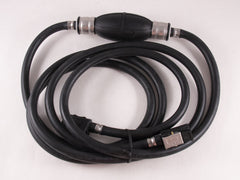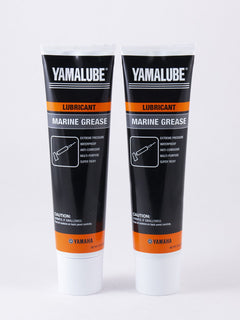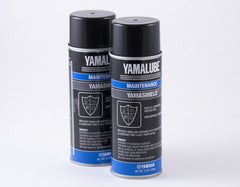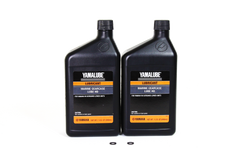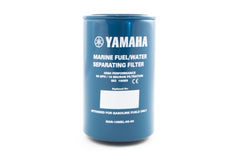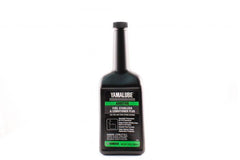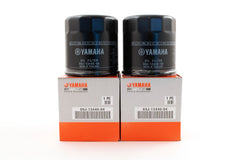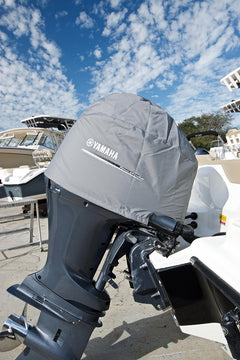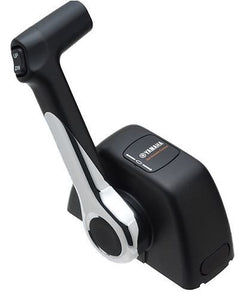Tips to Protect Your Yamaha Outboard from Corrosion
The most important thing to understand is that corrosion can affect just about any part of your outboard, including the fuel system, electrical connections, and internal cooling water passages. Watch out for dry corrosion, which occurs in areas of the motor that are not in direct contact with water, but corrosion can still eat away at exposed surfaces.
To protect your Yamaha outboard from corrosion, use the following best practices o protect your engine year-round:
- Flush your outboard after each use
- Keep your outboard clean
- Use corrosion inhibitors
- Use marine-grade grease
- Replace anodes
- Store your outboard properly
In the following sections, you’ll learn how to protect your Yamaha outboard from the harmful effects of salt water and moisture.
Flush your outboard after each use
Freshwater flushing is a necessary maintenance procedure for your Yamaha outboard, as it helps to remove salt, sand, and other contaminants that can cause corrosion and damage to your engine. Yamaha offers products specifically designed for cleaning outboard motor water passages. Here's how to clean outboard water passages with Yamaha products:
Materials:
Instructions:
- First, remove the engine cover, locate the water intake screens, and flush ports on the outboard motor. Make sure the engine is turned off and cool to the touch.
- If you have the Yamaha Engine Flushing Kit, install it according to the instructions.
- Add the recommended amount of Yamaha Ring Free Plus Fuel Additive to the fuel tank and fill the tank with fresh fuel.
- Start the engine and idle for several minutes to circulate the Ring Free Plus through the motor.
- Turn off the engine and allow it to cool down for a few minutes.
- Remove the spark plugs from the motor and spray a small amount of Yamaha Yamalube Engine Fogging Oil into each cylinder to protect against corrosion.
- Use a Yamaha engine flushing attachment or connect a garden hose to the flushing port to flush the engine with fresh water for at least 10 minutes, or as Yamaha recommends. This will help to flush out any debris or buildup from the water passages.
- Turn off the water and engine and remove the flushing attachment or hose.
- Reinstall the spark plugs and engine cover.
Note: It's important to note that Yamaha outboards may have different flushing procedures depending on the specific model and year, so it's always a good idea to consult the owner's manual for your particular outboard to ensure you're following the correct procedure. Additionally, it's recommended to freshwater flush your outboard after each use in saltwater or brackish water to help prevent corrosion and extend the life of your engine.
Keep your outboard clean
Regularly wash the exterior of your outboard and boat with fresh water to remove any salt and debris contributing to corrosion. This is especially true after taking your boat on the water. Once the outboard is free of debris, thoroughly wipe down the exterior of any leftover moisture.
Use corrosion inhibitors
To protect your outboard from the corrosive effects of salt water and moisture, Yamaha recommends using corrosion inhibitors both in the internal systems and exterior of your outboard. Here are several tips and products you should use:
Metal surfaces: Use Yamashield Rust & Corrosion Protectant on all metal surfaces. The corrosion inhibitor spray will create a protective barrier that helps prevent moisture and salt from corroding the metal surfaces of the motor. It's recommended to reapply the spray every few months, particularly if the motor is used in a harsh marine environment.
First, to use a Yamaha corrosion inhibitor spray on a Yamaha outboard, ensure that the motor is clean and dry. Shake the can well and spray a liberal amount of the corrosion inhibitor onto all metal surfaces of the motor, including the engine, gearbox, and propeller. Be sure to apply the spray evenly and thoroughly, taking care not to miss any areas. Allow the spray to dry completely before storing the motor.
Fuel system: Fuel Stabilizer and Conditioner Plus will help prevent the fuel from breaking down and oxidizing, which can lead to corrosion and other fuel-related issues. Regular use of a fuel stabilizer can help keep your Yamaha outboard motor running smoothly and prevent costly repairs down the line.
To use a Yamaha fuel stabilizer on a Yamaha outboard to prevent corrosion, first, add the recommended amount of stabilizer to a full tank of fuel. It's best to add the stabilizer before adding the fuel to ensure it's thoroughly mixed. Run the engine for several minutes to allow the stabilized fuel to circulate throughout the motor's fuel system.
Additionally, using fresh fuel and replacing any fuel that has been sitting for an extended period is essential, as old fuel can also contribute to corrosion and other engine problems.
Electrical connections: Apply Yamaha Marine Silicone Seal to electrical connections to protect against moisture and corrosion. The silicone seal is a non-conductive, waterproof sealant that can be applied to electrical components to help prevent corrosion and maintain proper electrical contact.
Use marine-grade grease
Regularly lubricate all moving parts, such as the steering system, throttle control, and shift linkages, with marine-grade grease to protect them from moisture and salt. Yamaha offers a variety of greases that can be used to help prevent corrosion on boats and outboard motors. Here are some general guidelines on where and how to apply Yamaha grease for corrosion prevention:
- Propeller shaft and propeller: Apply Yamaha Marine Grease to the propeller shaft and propeller after each use in saltwater to prevent corrosion and ensure smooth operation. The grease will help to protect these components from saltwater and other contaminants that can cause corrosion.
- Steering system: Apply Yamaha Marine Grease to the steering system components, including the steering cable, steering shaft, and steering linkage, to prevent corrosion and ensure smooth operation.
- Trailer components: Apply Yamaha Marine Grease to trailer components, including the trailer hitch, wheel bearings, and other metal components, to prevent corrosion and ensure smooth operation. It's also important to regularly rinse the trailer with fresh water after each use in saltwater to remove any salt residue that can cause corrosion.
When applying Yamaha grease, follow the instructions on the product label and apply the appropriate amount for the specific application. It's also important to regularly inspect all metal components for signs of corrosion and take appropriate steps to address any identified issues. By using Yamaha grease and following good maintenance practices, boaters can help to prevent corrosion and extend the life of their boats and outboard motors.
Replace anodes
Anodes are sacrificial metal parts that corrode instead of the metal parts of your outboard. Regularly inspect and replace your anodes to ensure they function properly and protect your outboard from corrosion.
What are anodes?
Anodes are metal components designed to corrode preferentially to other metal components in your Yamaha engine. Anodes are typically made of metals such as aluminum, zinc, or magnesium, and they are installed on the motor in areas that are most susceptible to corrosion.
Types of anodes
Yamaha outboard motors employ two primary kinds of anodes: sacrificial anodes and impressed current anodes. The former is the more prevalent type, which operates by corroding instead of other parts of the motor. Meanwhile, the latter is a more advanced kind that employs a small electrical current to actively prevent corrosion.
Anode placement
Anodes on Yamaha outboard motors are installed in areas most vulnerable to corrosion, such as the propeller, the gearbox housing, and the engine cooling system. Sacrificial anodes are typically placed on the transom bracket or in the cooling system, while impressed current anodes may also be positioned in other areas.
Anode maintenance
To ensure that your anodes are providing adequate corrosion protection, it's essential to inspect them regularly (at least every 6 months) and replace them if necessary. For trim tab anodes, which are important for steering, this is even more important and should be prioritized before you go out on the water.
You should also clean the anodes periodically to remove any buildup or corrosion. Cleaning is a simple procedure, just requiring a light brushing with a wire brush to expose the new metal. If the anode is corroded to 50% or less of its original size, it’s time to replace them.
By understanding the importance of anodes and maintaining them properly, you can help prevent corrosion and extend the life of your Yamaha outboard motor.
Store your outboard properly
When not in use, proper storage of your outboard is extremely important to prevent corrosion - especially when you won’t use it for weeks or months.
Luckily, storing your Yamaha outboard engine is relatively simple and includes most of the corrosion prevention procedures outlined throughout this guide. Here’s a list of the most essential steps you should follow:
- First, rinse the motor thoroughly with fresh water to remove salt or debris.
- Next, apply a high-quality, water-displacing lubricant to all metal surfaces.
- Remove the propeller and inspect it for any signs of damage or wear. Replace the propeller if necessary, and apply a thin layer of waterproof grease to the shaft before reinstalling the propeller.
- Flush the engine cooling system with fresh water to remove any remaining salt or debris.
- Thoroughly dry the entire engine and any other surfaces where water may collect
- Check the anodes and replace any that are significantly corroded or worn.
- Disconnect the battery and store it in a cool, dry place, ideally connected to a trickle charger, to maintain its charge.
- Cover the motor with a high-quality, breathable cover to protect it from dust, debris, and UV damage.
- Keep the engine area dry during storage. For long-term storage, such as winterization, you’ll want to ensure that the outboard is completely sealed or stored in an area with a dehumidifier.
By following these steps, you can help ensure that your Yamaha outboard motor remains in good condition and is ready to use when you're ready to hit the water again.

